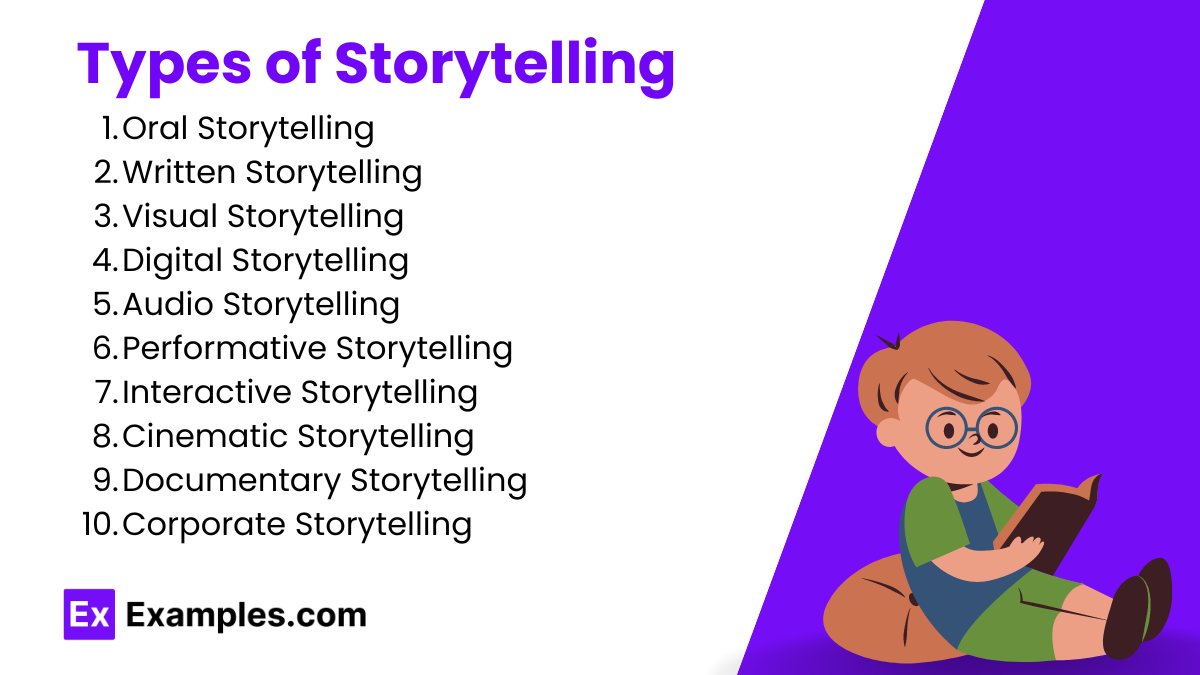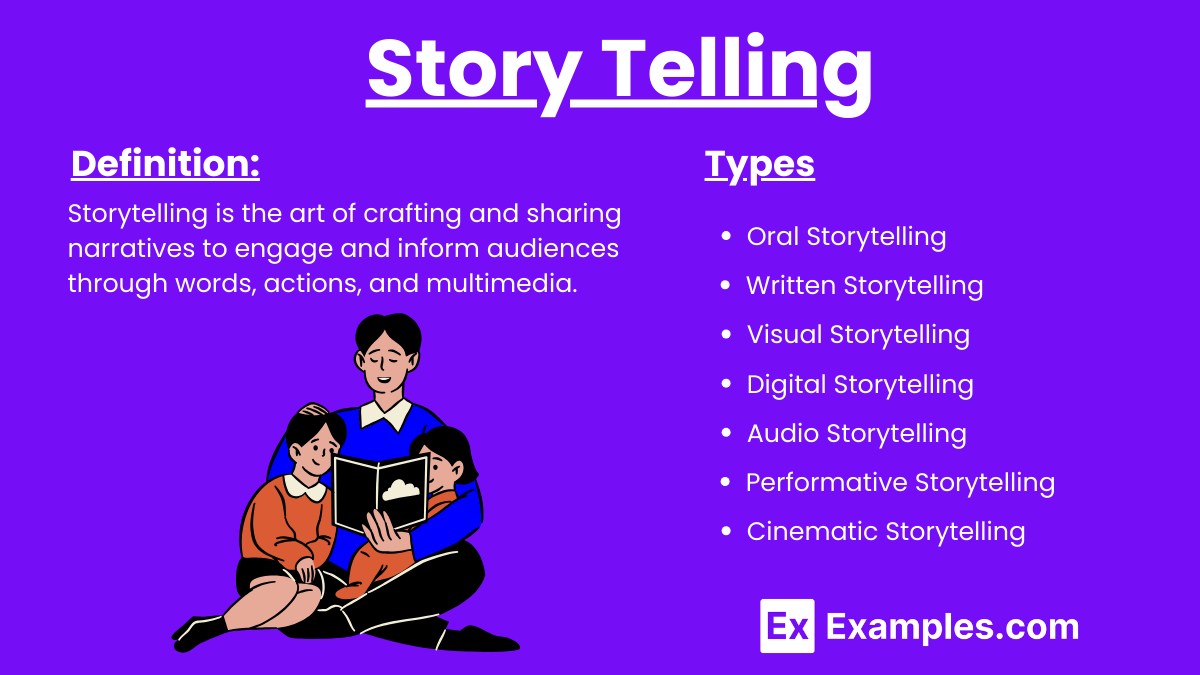15+ Story Telling Examples
Storytelling is the art of using words and actions to create and convey stories that captivate, inform, and entertain an audience. It involves narrating events with rich details and emotions to engage listeners and evoke their imagination. Effective storytelling can be found in oral traditions, written literature, movies, and digital media. This skill helps preserve cultures, impart morals, share experiences, and connect people through shared narratives. Storytelling in Communication makes messages memorable and impactful, while Storytelling in Oral Communication uses spoken words, tone, and gestures to enhance engagement. Storytelling as a Communication Skill is invaluable in business and education, connecting with audiences emotionally and making information relatable. Internal Storytelling shapes our beliefs and decisions, demonstrating the power of storytelling in every aspect of life.
What Is Storytelling?
Storytelling is the art of crafting and sharing narratives to engage and inform audiences through words, actions, and multimedia. It plays a crucial role in communication, helping to convey complex ideas and emotions in a relatable manner. In storytelling in communication, narratives are used to build connections, influence, and inspire. Internal storytelling refers to sharing stories within organizations to foster culture, align teams, and drive engagement.
Examples of Storytelling
- Oral Traditions: Indigenous tribes passing down myths and legends through generations.
- Fairy Tales: Classic stories like “Cinderella” or “Snow White” that teach moral lessons.
- Personal Anecdotes: Sharing personal experiences to connect with an audience, such as a teacher sharing a childhood memory to illustrate a lesson.
- Novels: Long-form fiction like “To Kill a Mockingbird” by Harper Lee, weaving intricate plots and deep character development.
- Movies: Films like “The Lion King” that use visual and auditory elements to tell compelling stories.
- Television Series: Shows like “Breaking Bad” that develop complex narratives over multiple seasons.
- Plays: Stage performances such as Shakespeare’s “Hamlet,” where actors bring stories to life.
- Poetry: Works like Robert Frost’s “The Road Not Taken,” telling stories through verse.
- Songs: Ballads and lyrics, such as Bob Dylan’s “The Times They Are A-Changin’,” that convey stories and emotions through music.
- Podcasts: Serialized a stories like “Serial” that engage listeners with episodic storytelling.
- Comics and Graphic Novels: Visual storytelling mediums like “Maus” by Art Spiegelman, combining illustrations with narrative.
- Video Games: Interactive stories such as “The Last of Us,” where players are part of the narrative.
- Advertising: Commercials that tell stories, like the famous Coca-Cola Christmas ads.
- Corporate Presentations: Using storytelling in communication to make business presentations more engaging and memorable.
- Speeches: Public speaking events where personal or historical stories are used to inspire or persuade, such as Martin Luther King Jr.’s “I Have a Dream” speech.
Types of Storytelling

- Oral Storytelling: Traditional method involving spoken words, often seen in folklore and cultural narratives passed down through generations.
- Written Storytelling: Stories conveyed through text, including novels, short stories, essays, and articles.
- Visual Storytelling: Uses visual media like paintings, photographs, and illustrations to tell a story without words.
- Digital Storytelling: Combines multimedia elements such as video, a, images, and text to create interactive narratives, often shared online.
- Audio Storytelling: Narratives delivered through a formats such as podcasts, radio shows, and abooks.
- Performative Storytelling: Includes theater, dance, and live performances where actors and performers tell stories through their actions and expressions.
- Interactive Storytelling: Found in video games and virtual reality, where the audience or players influence the outcome of the story.
- Cinematic Storytelling: Uses film and television to create stories with visual, auditory, and emotional elements.
- Documentary Storytelling: Non-fiction storytelling that presents real-life events and facts, often through films, TV shows, or written narratives.
- Corporate Storytelling: Used in business to create engaging presentations, marketing campaigns, and brand narratives that connect with audiences on an emotional level.
Importance of Story Telling
- Cultural Preservation: Storytelling helps preserve traditions, customs, and history, passing them down through generations.
- Education: Stories make complex concepts easier to understand and remember, enhancing learning and retention.
- Emotional Connection: Stories evoke emotions, helping people connect on a deeper level and fostering empathy.
- Communication: Storytelling in communication clarifies ideas, making them more engaging and relatable.
- Entertainment: Provides enjoyment and relaxation, allowing people to escape reality and explore different worlds.
- Social Bonding: Sharing stories strengthens relationships and creates a sense of community and belonging.
- Influence and Persuasion: Effective storytelling can inspire change, influence opinions, and motivate action.
- Identity Formation: Helps individuals and groups define and express their identities through shared narratives.
Narrating Stories
1. The Tortoise and the Hare: A classic fable where a slow but steady tortoise wins a race against a swift yet overconfident hare, teaching the lesson that perseverance triumphs over arrogance.
2. The Boy Who Cried Wolf: A shepherd boy repeatedly tricks villagers into thinking a wolf is attacking his flock. When a wolf actually appears, no one believes him, highlighting the importance of honesty.
3. The Lion and the Mouse: In this fable, a small mouse repays a lion’s mercy by freeing him from a hunter’s net, showing that even the smallest creatures can help the mighty.
4. Hansel and Gretel: Two children navigate danger and deception to escape a wicked witch, illustrating themes of resilience and resourcefulness.
5. The Ant and the Grasshopper: An ant works hard all summer while a grasshopper plays. When winter comes, the ant is prepared, but the grasshopper suffers, teaching the value of hard work and planning.
Story telling for Kids
- The Very Hungry Caterpillar: Follow the journey of a small caterpillar who eats his way through a variety of foods before transforming into a beautiful butterfly, teaching kids about the life cycle of butterflies.
- Where the Wild Things Are: Join Max on his adventure to the land of the Wild Things, where he becomes king of the monsters but eventually longs to return home, highlighting themes of imagination and the importance of family.
- Goodnight Moon: This classic bedtime story takes children through a series of comforting and familiar bedtime rituals in a quiet, great green room.
- The Tale of Peter Rabbit: Follow the mischievous adventures of Peter Rabbit as he sneaks into Mr. McGregor’s garden, teaching lessons about curiosity and consequences.
- The Gruffalo: A clever mouse invents a fearsome creature called the Gruffalo to scare off his predators, only to encounter the real Gruffalo later, illustrating themes of wit and bravery.
- Room on the Broom: A kind witch and her cat are joined by several animals on their broomstick ride, showing the value of friendship and cooperation.
Story telling in Business
Storytelling in business is a powerful tool used to engage, persuade, and inspire employees, customers, and stakeholders. Here are some ways storytelling is used in the business world:
- Brand Stories: Companies create narratives about their origins, values, and missions to connect emotionally with customers. For example, a small bakery might share how it started from a family recipe passed down through generations.
- Customer Testimonials: Sharing real-life stories from satisfied customers can build trust and credibility. These stories highlight how a product or service solved a problem or improved someone’s life.
- Employee Stories: Businesses share stories about their employees’ experiences, achievements, and growth within the company. This can boost morale and showcase a positive company culture.
- Case Studies: These detailed stories show how a business successfully addressed a client’s challenges. They are used to demonstrate expertise and effectiveness in solving problems.
- Vision and Mission Statements: Companies use storytelling to convey their long-term goals and core values, helping to align and motivate employees and stakeholders.
- Marketing Campaigns: Advertisements often use storytelling to create memorable and relatable content that resonates with the target audience, making the brand more appealing.
Techniques of Story Telling
Character Development: Create well-rounded characters with distinct personalities, motivations, and growth throughout the story. Strong characters make the audience care about the narrative.
Plot Structure: Use a clear structure with a beginning, middle, and end. Common structures include the three-act structure, the hero’s journey, and the five-act play. A well-organized plot helps maintain the audience’s interest.
Conflict and Resolution: Introduce conflicts or challenges that the characters must overcome. This creates tension and keeps the audience engaged. Ensure that the story resolves these conflicts satisfactorily.
Setting: Establish a vivid setting that enhances the story’s mood and context. Detailed descriptions of time, place, and environment help immerse the audience in the narrative.
Point of View: Choose a perspective from which to tell the story, such as first-person, third-person, or omniscient narrator. The point of view influences how much the audience knows and how they connect with the characters.
FAQs
Why is storytelling important?
Storytelling preserves culture, educates, builds emotional connections, and influences opinions, making it vital for communication and relationship-building.
What are the key elements of storytelling?
The key elements are character development, plot structure, setting, conflict and resolution, dialogue, and theme.
How does storytelling enhance communication?
Storytelling simplifies complex ideas, making them relatable and memorable, thereby enhancing effective communication.
What are some common storytelling techniques?
Common techniques include character development, plot structure, pacing, dialogue, and the use of imagery and sensory details.
How can businesses use storytelling?
Businesses use storytelling for branding, marketing, customer testimonials, employee engagement, and investor pitches.
What is digital storytelling?
Digital storytelling combines multimedia elements like video, a, images, and text to create interactive, engaging narratives.
What is the role of conflict in storytelling?
Conflict introduces challenges for characters to overcome, creating tension and keeping the audience engaged.
How does storytelling build emotional connections?
Stories evoke emotions and empathy, helping audiences connect on a personal level with the characters and the message.
What is “show, don’t tell” in storytelling?
“Show, don’t tell” means using descriptive language and actions to convey the story, allowing the audience to infer details.
What is the difference between oral and written storytelling?
Oral storytelling involves spoken narratives, while written storytelling uses text. Both aim to engage and convey stories effectively.



